Island Stories:
![]() Danzig
Mine
Danzig
Mine
![]() Zeballos
Iron Mine
Zeballos
Iron Mine
![]() Conuma
Peak 1910
Conuma
Peak 1910
Alexandra Peak
Argus Mountain
Bate/Alava Sanctuary
Beaufort Range
Big Interior Mtn
Big Interior Mtn 1913
Part 1
Part 2
Bolton Expedition 1896
Cliffe Glacier
Clinton Wood
Comox Glacier
Comox Glacier 1922
Comox Glacier 1925
Comstock Mtn
Conuma Peak
Copper King Mine
Crown Mtn
Elkhorn 1912
Elkhorn 1949
Elkhorn 1968
Eugene Croteau
Golden Bullets
Golden Hinde 1913/14
Golden Hinde 1937
Golden Hinde 1983
Harry Winstone Tragedy
Jack Mitchell
Jim Mitchell Tragedy
John Buttle
Judges Route
Koksilah's Silver Mine
Landslide Lake
Mackenzie Range
Malaspina Peak
Mariner Mtn
Marjories Load
Matchlee Mountain
Mount McQuillan
Mt. Albert Edward
Mt. Albert Edward 1927
Mt. Albert Edward 1938
Mt. Becher
Mt. Benson 1913
Mt. Benson
Mt. Doogie Dowler
Mt. Colonel Foster
Mt. Hayes/Thistle Claim
Mt. Maxwell
Mt. Sicker
Mt. Tzouhalem
Mt. Whymper
Muqin/Brooks Peninsula
Nine Peaks
Queneesh
Ralph Rosseau 1947
Rosseau Chalet
Ralph Rosseau Tragedy
Rambler Peak
Red Pillar
Rex Gibson Tragedy
Sid's Cabin
Steamboat Mtn
Strathcona Park 1980's
The Misthorns
The Unwild Side
Victoria Peak
Waterloo Mountain 1865
Wheaton Hut/Marble Meadows
William DeVoe
Woss Lake
You Creek Mine
Zeballos Peak
Other Stories:
Sierra
de los Tuxtlas
Antarctica
Cerro del Tepozteco
Citlaltepetl
Huascaran
Mt. Roraima
Nevada Alpamayo
Nevada del Tolima
Nevado de Toluca
Pico Bolivar
Popocatepetl
Uluru/Ayers Rock
Volcan Purace
Volcan San Jose
Big
Interior Mountain:
The
Mountain and the Miners
by Lindsay Elms
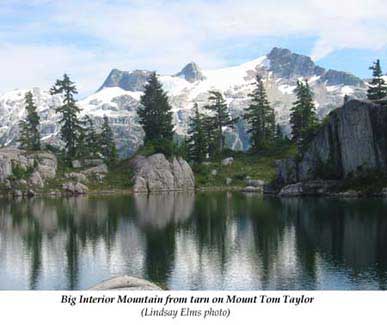 Shimmering
in the afternoon sun above Bedwell Lake in Strathcona Provincial Park
is Big Interior Mountain. Although not one of the highest on Vancouver
Island, this mountain vies with the clouds to fill up the sky. Its remote
slopes and valleys have for the last century seen a flurry of human activity,
from prospectors and mountaineers, to men and women from all walks of
life. It is the association of these people that give the mountain a unique
and interesting history.
Shimmering
in the afternoon sun above Bedwell Lake in Strathcona Provincial Park
is Big Interior Mountain. Although not one of the highest on Vancouver
Island, this mountain vies with the clouds to fill up the sky. Its remote
slopes and valleys have for the last century seen a flurry of human activity,
from prospectors and mountaineers, to men and women from all walks of
life. It is the association of these people that give the mountain a unique
and interesting history.
Big Interior is not a very inspiring name for a mountain, but it is aptly descriptive. On an 1896 map drawn by the exploring rector Reverand William Bolton, the mountain was named Laing's Neck Range in honour of his companion John Laing. This interesting name was never taken seriously and Laing's association has been long forgotten. It is possible that the mountain received its present name in 1899 when its rocky summit was first reached by Joe Drinkwater, an Alberni Valley resident.
A geologist remarked to Joe Drinkwater that to travel overland from Bedwell Sound to Alberni, via Great Central Lake, was probably an impossible undertaking. Drinkwater, accustomed to the tough rigours of outdoor life, accepted the geologist's challenge. Taking a boat from Tofino, he paddled up to the head of Bedwell Sound and from there hiked up the Bear (Bedwell) River. In the mid 1860's after explorers had found gold in the Bear River, prospectors swarmed into the valley and built a trail that was maintained until the mid 1880's. That's when the Chinese placer miners finally left the area due to superstitious circumstances that they never elaborated on to the public.
In the upper reaches of the Bear River the valley forks. This right branch is called You Creek. Drinkwater followed You Creek to Bear Pass, a low point on the ridge between Big Interior Mountain and the neighbouring Nine Peaks, and stopped for a well-deserved rest. Joe Drinkwater was a typical pioneer, a jack-of-all-trades. He had dabbled in mineral prospecting and to him the colour in the rocks near the summit of Big Interior Mountain looked interesting, requiring further investigation. Arriving on the summit, Drinkwater found enough copper to make it worth staking a claim thus proving his intuition correct. In the late afternoon he returned to his camp on Bear Pass and watched the last of the sun's rays dip behind the mountain.
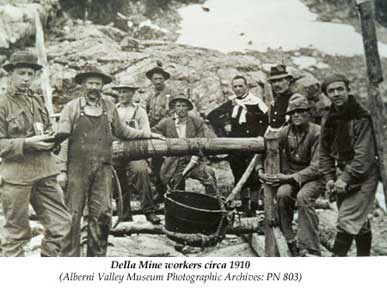 Below
the pass he could see a beautiful lake nestled in a basin but to get to
it required some steep down-climbing. Carefully he made his way down making
sure of every hold as a slip would be fatal especially since he was unroped.
While hiking around the lake he took note of the minerals in the rock
and found that this time it contained gold. Again he took the time to
stake another claim and then he cautiously made his was to the outlet
of the lake. Echoing up from over the edge could be heard a thunderous
roar. There below him was a dizzying drop: the river cascaded over the
edge and dropped four hundred and forty metres to the valley floor, not
in one big leap but in a series of three falls. Finding a route down the
cliff was time consuming but he eventually reached the bottom safely.
Now all he had to do was hike out to Great Central Lake and then paddle
down the lake to Alberni.
Below
the pass he could see a beautiful lake nestled in a basin but to get to
it required some steep down-climbing. Carefully he made his way down making
sure of every hold as a slip would be fatal especially since he was unroped.
While hiking around the lake he took note of the minerals in the rock
and found that this time it contained gold. Again he took the time to
stake another claim and then he cautiously made his was to the outlet
of the lake. Echoing up from over the edge could be heard a thunderous
roar. There below him was a dizzying drop: the river cascaded over the
edge and dropped four hundred and forty metres to the valley floor, not
in one big leap but in a series of three falls. Finding a route down the
cliff was time consuming but he eventually reached the bottom safely.
Now all he had to do was hike out to Great Central Lake and then paddle
down the lake to Alberni.
Knowing that he would have to return via the waterfall and the lake to the two claims that he had staked, he decided to give them names. To both features he gave the name - Della, in honour of his wife. Over the years Della often visited these places with her husband while he worked the claims. Still today the highest waterfall in Canada is called Della Falls and the lake in the basin is called Della Lake in her memory.
Drinkwater teamed up with Alvin Engvik of Vancouver and between 1900 and 1915 considerable work was undertaken at the Della Lake mine site. A good pack-trail was built up the Drinkwater Valley and an aerial cable-way was constructed from the valley floor to the top of Della Falls. On the west shore of Della Lake along the vein of gold-bearing quartz, a water driven arrastra was built. This was a crude ore-crushing device used to extract free gold from the quartz samples. The gold was then transported down thecable-way in large buckets, one of which can still be seen laying next to an open-pit shaft beside the lake, and then taken down to Great Central Lake by pack horse.
In 1915, the property was bonded by a Vancouver company that proposed starting systematic development work. The plan was to build a cyanide concentrating plant to extract the gold, but due to the unusually deep snow that covered the surface late in the season of 1916, work was postponed.
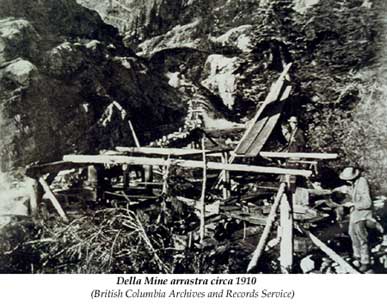 After
that very little work was undertaken at the mine except when gold prices
were looking good. In 1938 samples were brought out from the Della Mine
and assayed at over an average of one ounce of gold per ton, gold at that
time was valued at $35 per ounce.
After
that very little work was undertaken at the mine except when gold prices
were looking good. In 1938 samples were brought out from the Della Mine
and assayed at over an average of one ounce of gold per ton, gold at that
time was valued at $35 per ounce.
Meanwhile, on the summit of Big Interior Mountain, there were major plans in progress to mine the copper. In 1912 the claims, known as the Ptarmigan Mine, were purchased by a small group of international investors, chaired by Rudolph Robert Feilding, the 9th Earl of Denbigh from England, at a cost of a quarter of a million dollars. The following year the Earl, his twenty-one year old daughter Lady Marjorie Feilding, and a number of friends and mining consultants accompanied them on an inspection of the mine site. The party left Victoria in mid September and gained the mountain via Great Central Lake, Drinkwater Creek, Della Falls and Della Lake.
To commemorate Lady Marjorie's ascent to the summit, it was decided to record a new peak on the physical feature map by christening one of the minor spires of Big Interior Mountain by the name "Marjorie's Load." This name was never popularized and has since fallen into obscurity.
The Earl's party descended to the Bear (Bedwell) River where they hiked out to Bedwell Sound. Here the ship Queen City, which they had chartered, was waiting for them to take them back to Victoria. Considerable work had taken place in the last year in order to get the mine ready for production. A landing had been built at Bedwell Sound and a wagon road constructed to within three miles of the base of the mountain. In that distance were twenty-five bridges spanning the canyons of the river.
At the end of the road, cable and terminals for the construction of an aerial tramway that was to rise for five thousand feet to the mine site, was lying ready to erect. This equipment was from the Tyee Mine on Mount Sicker near Duncan. Another month or two would have seen the road finished and then it was hoped production would begin in July 1914. It was expected the plant would have a capacity of one thousand tons a day, and from Bedwell Sound the ore would be transported by steamer to the Tyee Smelter at Ladysmith. However, the investors never saw any financial reward from the project. Construction came to a halt due to the First World War and later development was inhibited by the establishment of Strathcona Provincial Park.
While the Earl of Denbigh's crew was road building in the Bedwell, prospectors found a rich quartz vein containing gold on the southwest slopes of Big Interior Mountain. Access was via the You Creek, one of the largest tributaries of the Bedwell River, first travelled by Joe Drinkwater. The four claims were known as Ex, Ten, You and Eight and became Crown Grants in 1921. In 1923 a small cyanide mill was installed and although no figures on its production are available, remains suggest a capacity of five to ten tons per day. In 1932, the owner with a small crew, worked for a couple of months rebuilding the old camp and reconditioning the mill. Test runs showed that recoveries could be made by concentrating and cyaniding the ore and it was estimated that sufficient tonnage was available to make the property a profitable producer. Further samples were taken but by 1933 it was realized that the lack of transportation facilities was going to handicap the mine's production and it eventually was abandoned, left to stand as a ghost town.
Reports from the prospectors and assayers over the years gave every indication that the mine sites on Big Interior Mountain could easily have developed into one of the largest mining areas on Vancouver Island. Prospectors and miners were upset that the area never came into full production, as they could have benefited from the opportunities. The area now retains its wilderness value within the boundaries of Strathcona Park and the old mine sites are a unique historical museum in situ. Although there is very little mining evidence to be seen, the area has become a popular destination for hikers and climbers who wish to mix their experience with a piece of the Island's history.
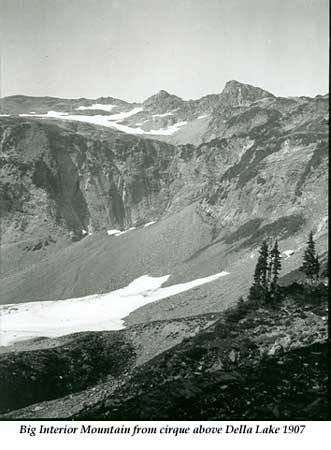 |
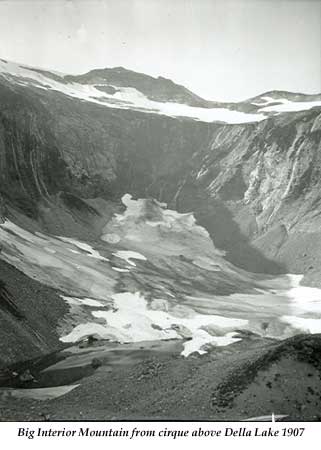 |
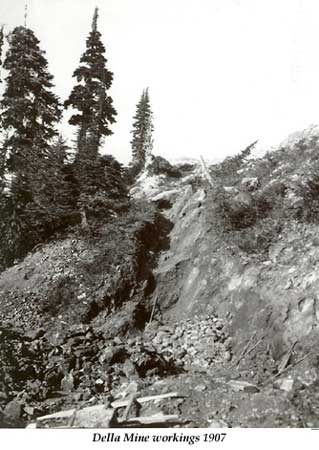 |
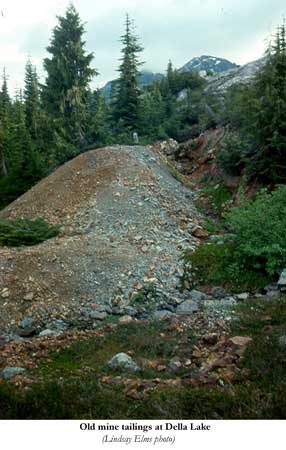 |
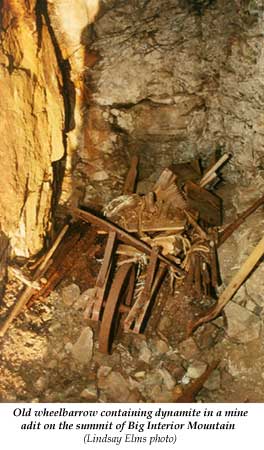 |
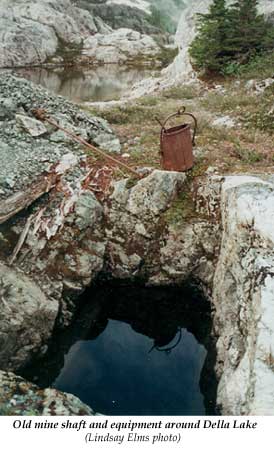 |
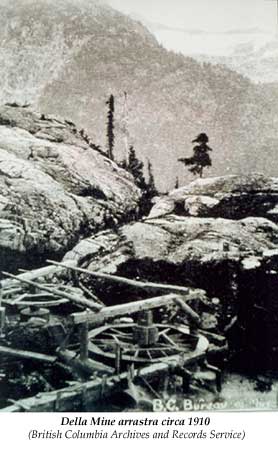 |
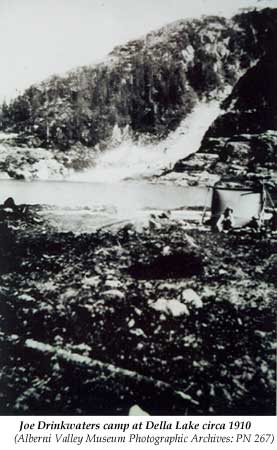 |
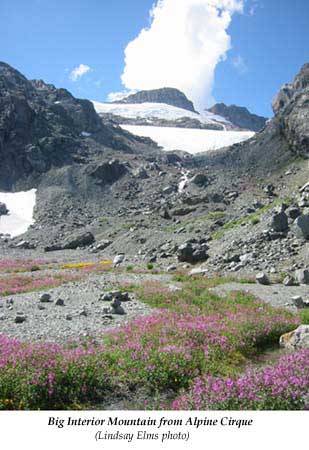 |
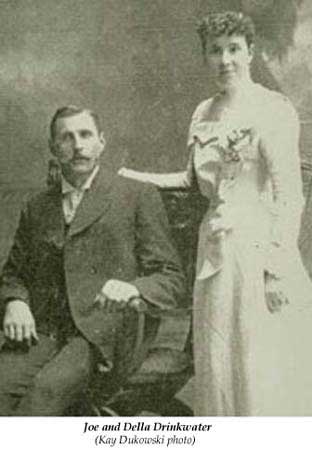 |
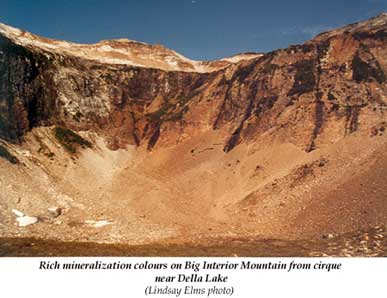 |
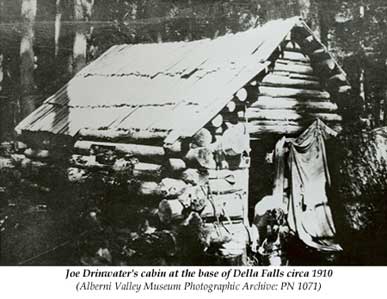 |
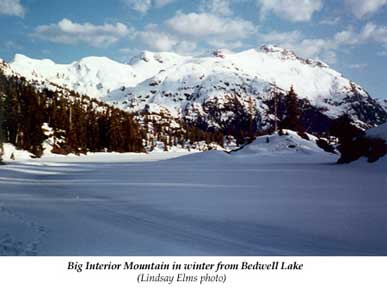 |
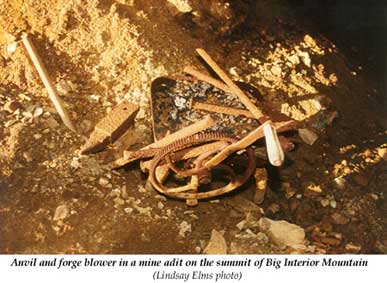 |
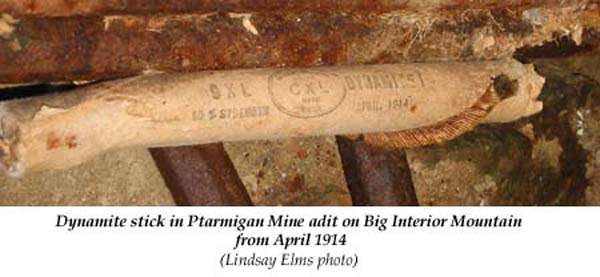 |
|
How to order | | About the Author || Links || Home
Contact:
Copyright ©
Lindsay Elms 2001. All Rights Reserved.
URL: http://www.beyondnootka.com
http://www.lindsayelms.ca
